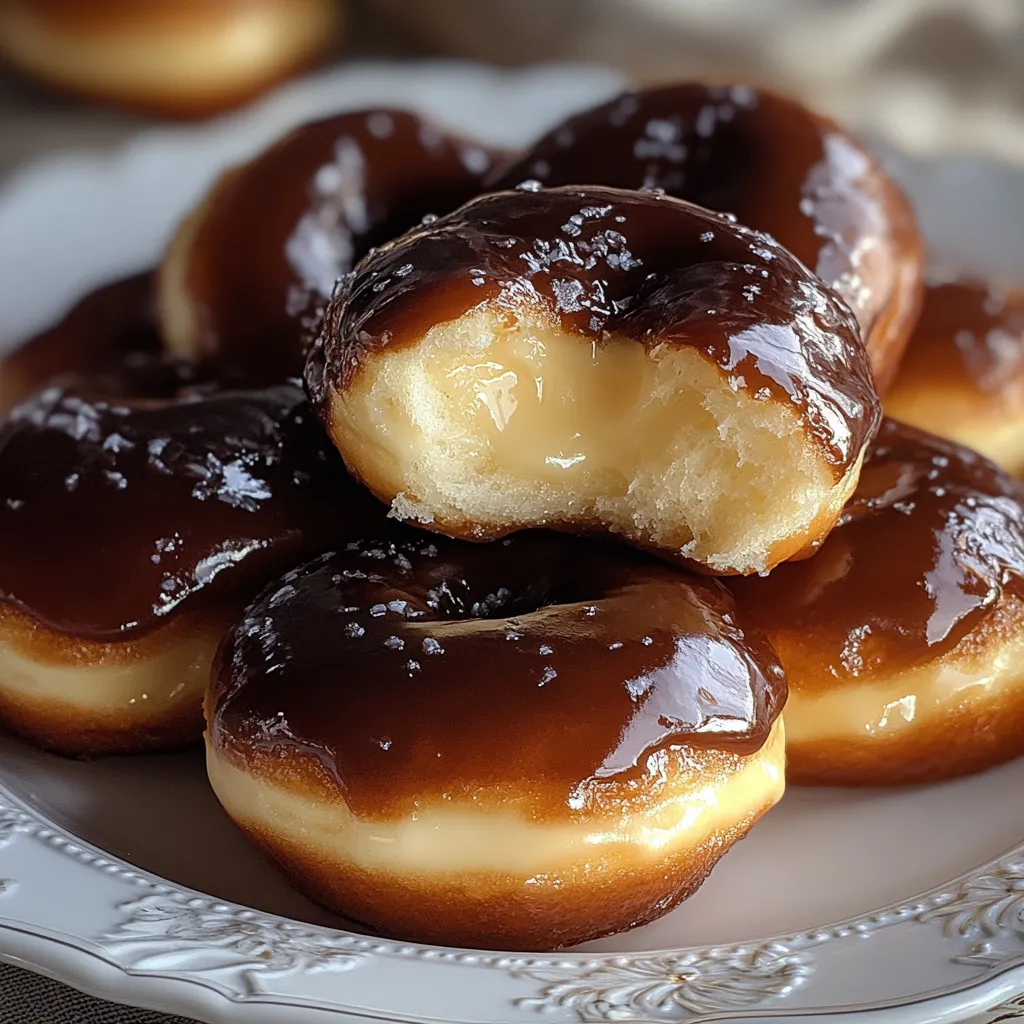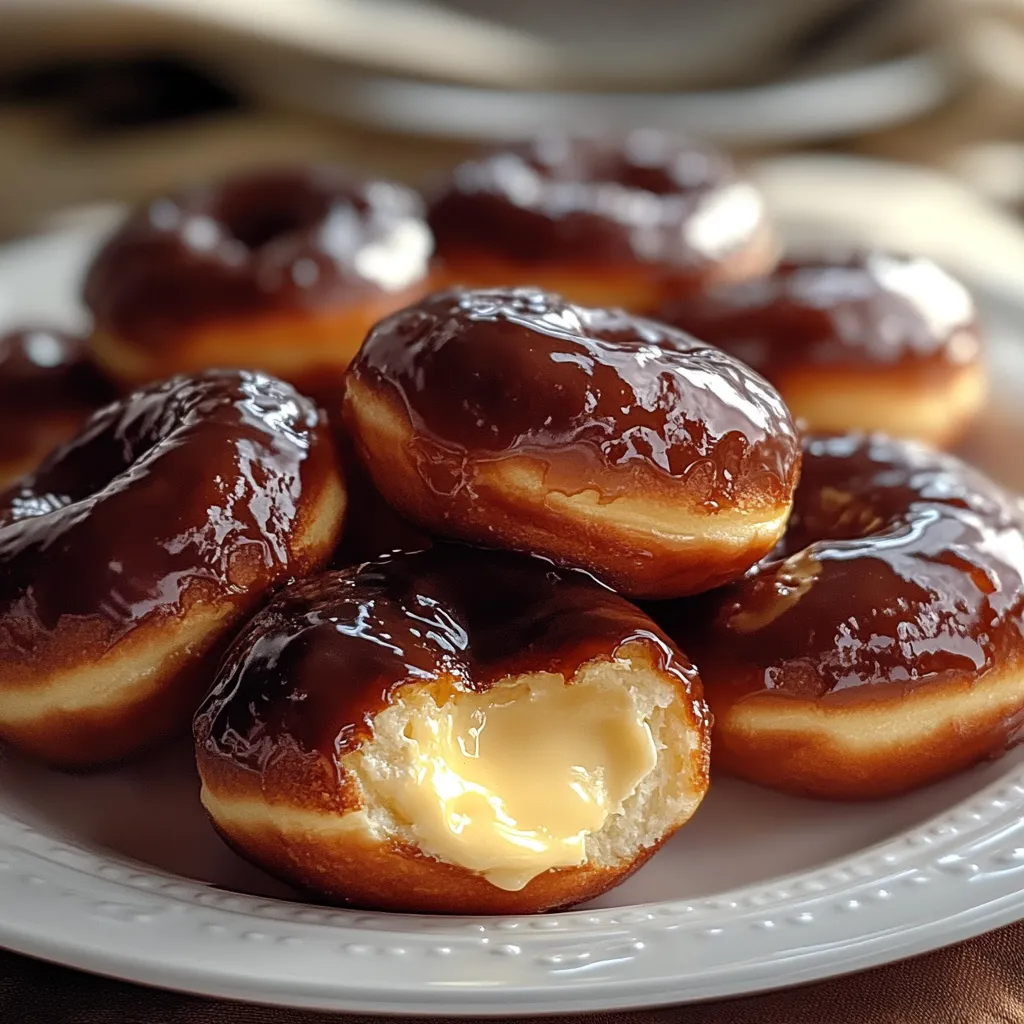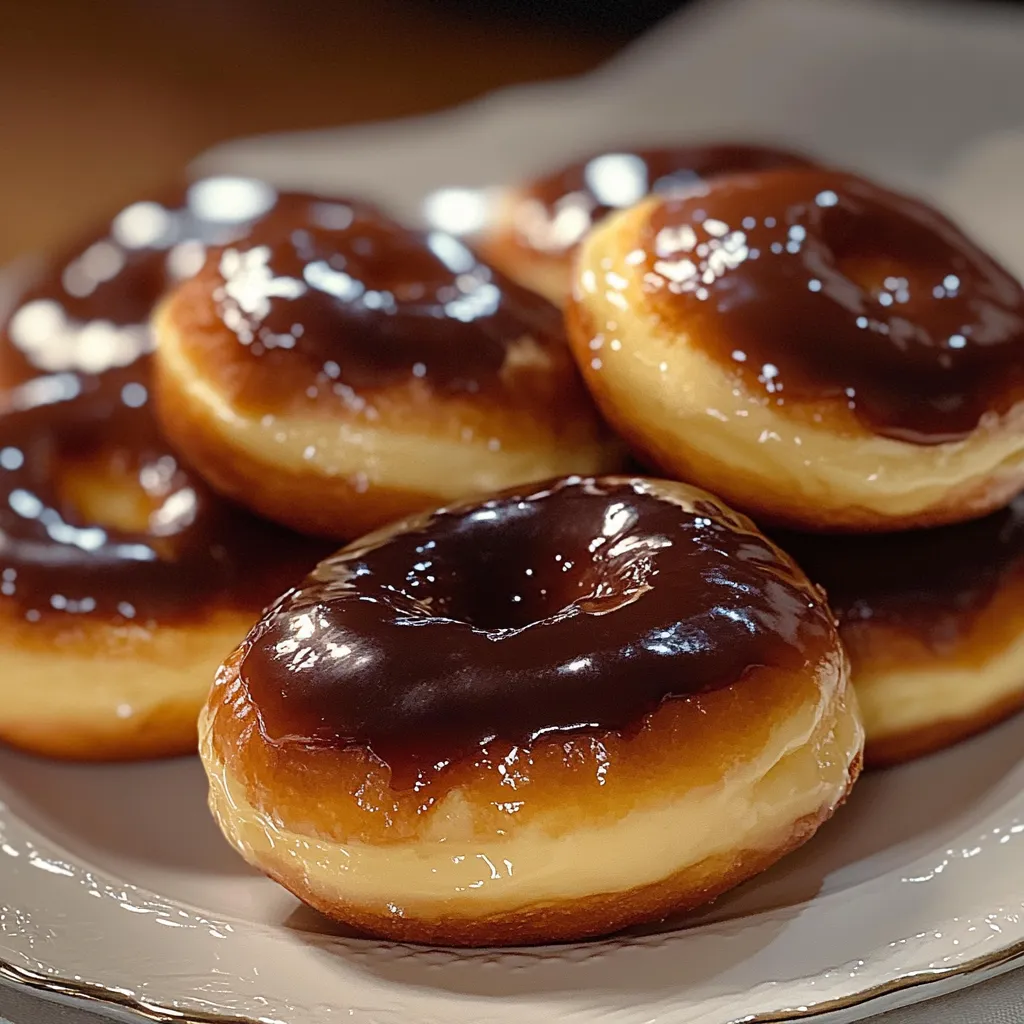 Pin it
Pin it
Crème Brûlée Donuts combine two beloved desserts into one extraordinary treat that delivers multiple texture experiences in a single bite. The pillow-soft yeasted dough yields to reveal silky vanilla bean custard filling, while the signature caramelized sugar topping provides that unmistakable crack when broken with a fork or bite. This clever fusion takes the refined elegance of classic French custard and transforms it into an approachable handheld delight that maintains all the sophistication of the original dessert.
I first encountered these donuts at a local bakery where people lined up around the block each morning just to secure one before they sold out. After watching the pure joy on my daughter's face when she took her first bite, I became determined to recreate them at home. My initial attempts resulted in decent donuts but lackluster caramel tops until I discovered the secret of using a kitchen torch for that perfect crack. What surprised me most was watching my typically health-conscious mother-in-law abandon all restraint and request a second donut during Sunday brunch. The combination of familiar flavors in an unexpected format seems to make even the most disciplined eaters willing to indulge.
Essential Elements
- Active dry yeast: Creates perfectly risen dough with ideal texture. Check expiration dates since fresh yeast produces most reliable results.
- Bread flour: Provides ideal structure and chew for authentic donut texture. Higher protein content develops better gluten network than all-purpose alternatives.
- Egg yolks: Form foundation of silky custard filling while contributing richness to dough. Farm-fresh eggs with vibrant orange yolks produce most flavorful results.
- Vanilla bean: Infuses custard with authentic flavor and distinctive speckled appearance. Madagascar varieties offer superior aromatic qualities compared to extracts.
- Heavy cream: Creates luxurious mouthfeel in custard filling. Higher butterfat percentages produce richest results.
- Granulated sugar: Forms glass-like caramelized topping when properly heated. Pure cane sugar caramelizes more predictably than beet sugar varieties.
Creation Process
- Prepare enriched dough:
- Activate yeast in warm liquid allowing it to bloom completely before proceeding. Mix flour with sugar and salt creating dry foundation for dough. Incorporate eggs, butter, and flavorings gradually developing elastic texture through proper kneading. Allow dough to rise until doubled in volume developing complex flavors and airy structure.
- Create silky custard:
- Heat milk with split vanilla bean infusing liquid with aromatic flavor compounds. Whisk egg yolks with sugar and cornstarch creating smooth base that will thicken properly. Temper egg mixture with hot milk preventing curdling while maintaining proper emulsion. Cook mixture until nappe consistency develops coating back of spoon perfectly.
- Shape perfect circles:
- Roll dough to even thickness maintaining consistent air distribution throughout. Cut circles using proper diameter cutter avoiding twisting motion which can seal edges. Allow cut donuts to proof until visibly puffy and light to touch indicating proper development.
- Fry with precision:
- Heat oil to exact temperature ensuring proper expansion without excessive oil absorption. Fry donuts until golden brown maintaining light interior while developing flavorful exterior. Drain thoroughly removing excess oil for best texture and flavor experience.
- Fill with finesse:
- Cool donuts completely preventing custard from breaking or melting when piped inside. Insert piping tip deeply creating space for generous filling distribution. Fill until donut feels slightly heavier but not overstuffed which could cause bursting.
- Create signature topping:
- Apply thin layer of granulated sugar across donut top creating even foundation for caramelization. Use kitchen torch with sweeping motion transforming sugar into amber glass-like surface. Allow caramel to cool completely developing proper crack-like texture.
- Serve at peak perfection:
- Enjoy donuts within hours of finishing for ideal texture contrast between elements. The brief waiting period allows flavors to meld while maintaining distinct textural differences between components.
 Pin it
Pin it
My first attempt at these donuts taught me valuable lessons about patience with the dough. I rushed the rising process and ended up with dense, heavy donuts rather than the light, airy texture essential to balance the rich filling. Now I always allow at least two full rises, even if it means starting the process a day ahead. I've also learned that using a kitchen torch produces far better results than trying to dip the tops in hot caramel – the torch allows precise control over caramelization while maintaining the integrity of the custard beneath. The most surprising discovery was how well the components work together – the slight bitterness of the caramelized sugar perfectly balances the sweet vanilla custard while the soft donut provides the ideal neutral canvas.
Serving Inspiration
Pair with espresso whose bitterness complements caramelized sugar notes perfectly. Serve alongside fresh berries whose acidity balances rich custard filling. Consider presenting on individual plates with light dusting of powdered sugar surrounding donut for elegant presentation.
Creative Adaptations
Infuse custard with coffee creating tiramisu-inspired variation with complex flavor profile. Add orange zest to dough enhancing aromatic quality while complementing vanilla beautifully. Incorporate chocolate ganache layer between custard and caramel creating multi-layered flavor experience.
Storage Solutions
Consume within hours of assembly for optimal texture contrast experience. Store unfilled donuts at room temperature up to one day reviving briefly in 300°F oven before filling. Keep custard refrigerated separately up to three days, filling donuts just before serving for best results.
The first time I brought these donuts to a family gathering, the conversation completely stopped as everyone took their first bite. Three different relatives asked for the recipe before finishing, and my brother-in-law jokingly offered to pay me to make them weekly. What makes these treats truly special isn't just their delicious flavor combination but how they transform refined dessert elements into something approachable and fun. The interactive experience of breaking through the caramelized top creates a moment of anticipation that makes eating these donuts feel like a special occasion. While they require some effort, the process itself becomes rewarding as you master each component and bring them together into something greater than the sum of its parts.
 Pin it
Pin it
Frequently Asked Questions
- → Can I make these donuts ahead of time?
- You can prepare the dough and pastry cream a day ahead, but assemble and add the caramel top just before serving for the best texture contrast.
- → What if I don't have a kitchen torch?
- You can make a caramel sauce on the stovetop and dip the tops of the donuts, or place them under a very hot broiler for a few seconds (watch carefully!).
- → Why did my dough not rise properly?
- Check that your yeast is fresh and that the water/milk wasn't too hot (which can kill the yeast). Also, the environment should be warm enough for proper rising.
- → Can I bake these instead of frying?
- While you can bake the dough at 350°F for about 15 minutes, the texture won't be as authentic. Fried donuts have that distinctive pillowy quality.
- → My pastry cream is lumpy, what went wrong?
- Likely the eggs started to scramble. Next time, temper the eggs more gradually with the hot milk and stir constantly. You can strain the mixture to remove lumps.
- → How do I know when the oil is the right temperature?
- Use a candy thermometer to maintain 350°F. If you don't have one, drop a small piece of dough in the oil - it should bubble around the dough and rise to the surface in about 5 seconds.
